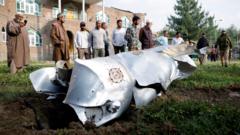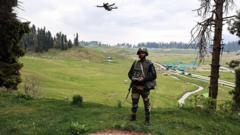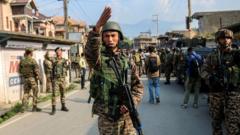India conducted missile air strikes on multiple sites in Pakistan, citing credible intelligence on militant targets, igniting fears of retaliation from Islamabad. Experts analyze the escalating tensions, potential responses from Pakistan, and the diplomatic challenges ahead.
After India's Air Strikes: Assessing Potential Responses from Pakistan

After India's Air Strikes: Assessing Potential Responses from Pakistan
A closer look at the implications of India's recent air strikes in Pakistan and the potential for escalated conflict or diplomacy.
In a rapid escalation of tensions between India and Pakistan, India launched missile strikes on nine locations across Pakistan and Pakistan-administered Kashmir, purportedly targeting militant positions based on "credible intelligence." This 25-minute operation at dawn triggered significant alarm within the region, with reports of multiple explosions waking residents. Pakistan has disputed India’s claims about the scale and intent of the strikes, asserting that only six sites were affected, and claiming to have shot down five Indian fighter jets.
The Indian military claims that 26 individuals were killed and 46 injured due to Pakistani retaliatory shelling across the Line of Control (LoC), while India reported ten civilian casualties due to the same. This conflict marks a worrying increase in hostilities, particularly following a deadly terrorist attack on Indian tourists in Pahalgam, Kashmir, which India attributes to Pakistan-based groups.
Analysts are contemplating whether this military engagement represents a new level of escalation in the already tense India-Pakistan relationship. Historically, similar situations have led to significant retaliatory strikes on both ends, notably India’s "surgical strikes" in 2016 and the Balakot airstrike in 2019 in retaliation for terrorist attacks.
This recent operation is marked by its expansive targeting, with India hitting deep into Pakistani territory, an aggressive move that has raised the stakes in the conflict. Experts note that such a comprehensive operation indicates India's intent to more severely punish militant groups such as Lashkar-e-Taiba and Jaish-e-Mohammed, signaling that multiple adversaries are now being addressed simultaneously.
Former Indian officials express the view that India’s response was aimed not only at retaliation but also at reinforcing deterrence against future attacks. However, this could instigate an equally robust retaliatory measure from Pakistan, leading to an uncontrolled cycle of escalation. Military analysts believe a swift retaliation from Pakistan is likely, given both the military’s public rhetoric and internal pressures.
Despite these tensions, some experts still advocate for diplomacy as a tool for de-escalation. They recognize the delicate balance both nations must maintain to avoid further conflict and suggest that any retaliatory actions taken by Pakistan may be held to focus on military targets to avoid broadening the conflict scope.
The volatility of the situation is compounded by internal dynamics in Pakistan, where political stability is precarious, and public sentiment can shift dramatically toward support for military intervention in times of national crisis. Analysts warn that while public enthusiasm for military engagement currently appears low, a significant shift in sentiment could energize the military’s public image as defenders of national honor against perceived Indian aggression.
Efforts at de-escalation, as seen after past crises, will be critical, requiring careful maneuvering by both sides to mitigate the risks of a broader conflict. Although both nations have found themselves resorting to mutual defensive measures recently, like suspending treaties and closing airspace, historical patterns indicate that dialogue has sometimes paved the way back from the brink of war, a hope some experts are holding onto amidst the rising tensions.





















